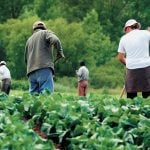Winter peas and lentils are yielding twice those of their spring cousins.
Kevin McPhee of the U.S. Department of Agriculture’s Agriculture Research Service in Pullman, Washington, has been breeding fall-seeded varieties of peas, lentils and zero-tannin fababeans for nearly a decade.
“At the southern Alberta site we have seen it,” he said.
“The early start, the right germplasm, the extra moisture – it all works in the crops’ favours.”
McPhee has developed two clear-white, flower type pulses that he feels will meet North American producers’ market needs and have the agronomic characteristics to make them successful on the Great Plains and Prairies.
Read Also

VIDEO: Green Lightning and Nytro Ag win sustainability innovation award
Nytro Ag Corp and Green Lightning recieved an innovation award at Ag in Motion 2025 for the Green Lightning Nitrogen Machine, which converts atmospheric nitrogen into a plant-usable form.
Windham winter pea and Morton winter lentil are showing signs of success in plot trials at the Southern Applied Research Association’s (SARA) agronomy site near Lethbridge.
McPhee said the peas and lentils are performing as well at the SARA site as they have been in the USDA’s Montana trials.
Ken Coles of SARA said the fall seeded crops are exciting news for Canadian growers.
“These are crops that not only perform well, they allow producers to take better advantage of their land, equipment, labour and available moisture. Just like a winter wheat crop, but in a pulse,” he said.
Agronomists suggest that winter pulses create opportunities for spring crop rotations and can also be produced in advance of winter wheat, providing nitrogen sequestration for that crop.
“In Europe, most producers are seeding in the fall these days, at the very least with a portion of their crops including canola and pulses,” Coles said.
Mark Olson of Alberta Agriculture said his province’s Ag Food Council, along with Alberta Pulse Growers and other investors, has created a $200,000 project to explore the crops for Canadian growing conditions.
“We have in-kind investments from USDA, University of Washington, from the (European Union), Novozymes, SARA and (Agriculture Canada). There is a lot of interest,” he said.
“Farmers hear about winter pulses and they are even more interested than anybody. The work at SARA is looking at a wide variety of things: agronomy, the growth stage timing, duration of winter, date of seeding, stubble conditions. And the economics are part of the work, too,” he said.
“Partners are looking at fibre, starch and protein components. We will have a full report on the winter pulses in March of 2012.”
With USDA’s five years of yield trials averaging 50 percent higher than the best spring seeded lentils and peas, McPhee said American growers are pushing to get supplies of seed now.
“We are in the grow-up stage (of seed supply production). Farmers in the Plains and (Washington) want seed for this fall.”
There are Canadian research plots at Lethbridge, Oyen, Camrose, Fahler and Fort Kent in Alberta and Swift Current in Saskatchewan.
“What we need now is to get a Canadian pulse breeder into this project and start developing a yellow pea for the market,” he said.
“So far it’s a green pea and green lentil. There are things we could do with our well developed breeding community here in Canada to take full advantage of these crops with new varieties.”
Coles said fall seeded pulses at Swift Current are suffering from winter kill.
McPhee said a tough winter at the Canadian sites is good for his breeding program.
“It tells me despite tough conditions the plants survive and still yield well, and it gives me some significant selection pressure to work with for next year.”














